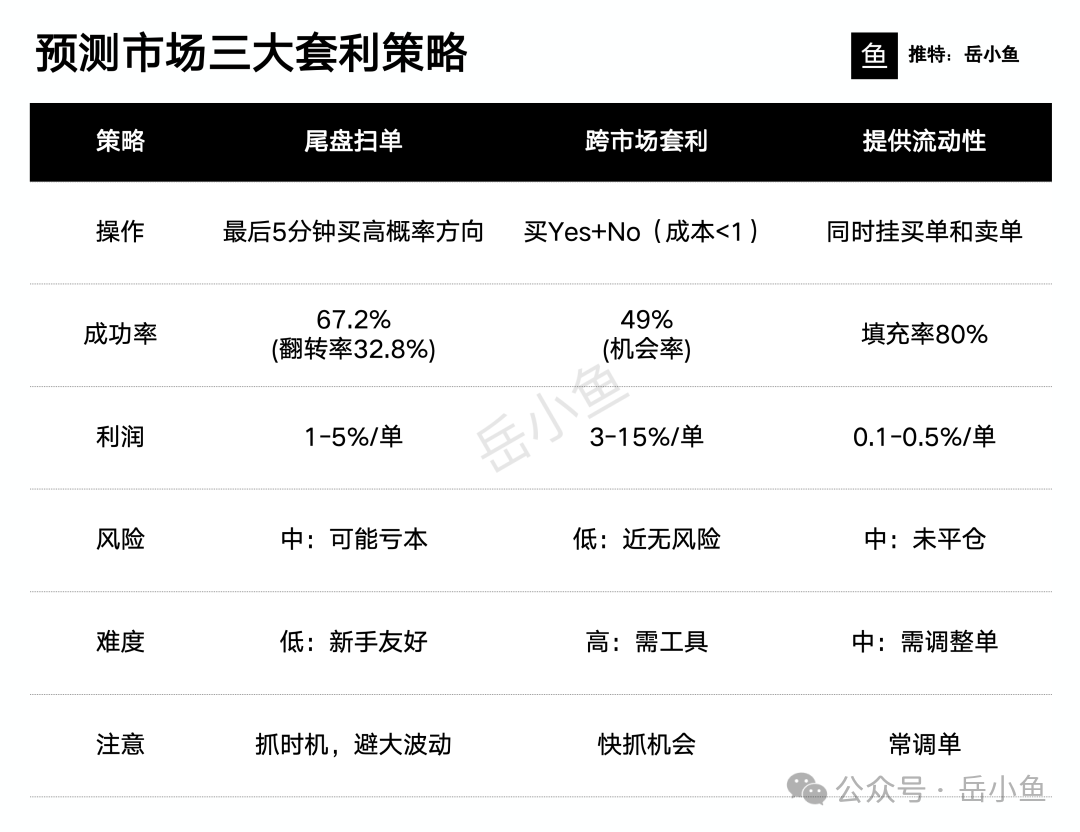Author: Yue Xiaoyu
The prediction market is definitely the next track with significant wealth effects! If RWA is transforming the traditional securities market, then the prediction market is transforming the traditional gambling market.
Every time a transformation occurs, it brings at least a tenfold increase in efficiency. Combined with blockchain technology, global liquidity, no identity barriers, high transparency, and low transaction costs—any one of these advantages represents a tremendous improvement over traditional systems.
In the previous article, I introduced some potential projects in the current prediction market track. In this one, I will directly guide you through practical operations and introduce relevant strategies.
I have been actively participating for two weeks and have developed some basic strategies that I hope will be helpful to everyone.
Overall, there are three main strategies: end-of-session sweep arbitrage, cross-market arbitrage, and providing liquidity.
1. End-of-Session Sweep Arbitrage
End-of-session sweeping involves participating in a prediction event just before it concludes.
The probability of a reversal in the final stages of a prediction market event is very low; the trend is basically confirmed, and the certainty is extremely high, but it has not yet reached 100%.
For example, regarding a prediction event about whether BTC's price will rise or fall, I used AI to backtest data from the past month:
The minute-level volatility of BTC is about 0.05-0.15%. In the last 5 minutes, a 0.5% reverse move is needed for a reversal, with a probability of only 21.3%.
This makes end-of-session buying a low-risk strategy, very suitable for ordinary users.
Currently, end-of-session sweeping is also a common strategy used by whales and bots, and the cumulative profits are quite considerable.
Specific operational steps:
Choose the market: Find the BTC 15-minute rise/fall market and the 1-hour rise/fall market on PolyMarket.
Monitor time: In the last 5 minutes, check the probability. If the probability is greater than 97%, it basically indicates that the result is confirmed.
Execute the buy: If liquidity is good, use a market order to buy directly; if liquidity is poor, you can use a limit order to buy.
Risk management: It is highly recommended to set a stop-loss! Set a sell order to sell when the probability drops to $0.90, to avoid losing too much principal in the event of a last-minute extreme reversal.
2. Cross-Market Arbitrage
Cross-market arbitrage refers to finding the total of Yes and No for the same prediction event to be less than 1, either on the same platform or different platforms, and buying all mutually exclusive events.
The predicted probabilities for the same event can differ across platforms, allowing for arbitrage based on price differences.
Especially on some new platforms with insufficient liquidity, there may be brief moments when the total of all outcomes for the same event is less than 1.
To engage in cross-market arbitrage, you need to use monitoring bots for real-time tracking and require automated operations, as the window of opportunity is relatively short.
Specific operational steps:
Scan the market: Compare the same event across different platforms like PolyMarket, Kalshi, and Opinion, calculating the total of Yes + No.
Identify opportunities: If the total is 1, for example, PolyMarket Yes 0.45, Kalshi No 0.49, with a total of 0.94, buy immediately.
Execute the buy: Use one wallet to buy 100 Yes shares on PolyMarket at $0.45 (45 USDC), and another to buy 100 No on Kalshi at $0.49 (49 USDC), with a total cost of 94 USDC.
Settlement: After the event settles, since the shares of Yes and No are the same and each is 100, you profit 100 USDC, with a profit of 6 USDC.
3. Providing Liquidity
As a liquidity provider (LP), you place buy and sell orders on the order book to earn the spread and receive platform rewards.
This strategy is not pure arbitrage but can yield nearly risk-free returns, suitable for neutral markets.
Similar to the market maker strategy in options, LPs earn 2 cents per transaction by placing orders (e.g., buying at 0.49/selling at 0.51) while also receiving liquidity rewards from the platform.
However, this strategy can also carry risks, such as significant price deviations, so frequent adjustments are necessary, making it suitable for users with more capital.
Specific operational steps:
Choose the market: Select a high liquidity market, such as BTC 1-hour Up/Down.
Place orders: On the order book, set a limit buy order at $0.49 and a sell order at $0.51 (100 shares, cost ~50 USDC).
Earn returns: Profit from the spread (2 USDC/100 shares); if not executed, earn LP rewards (~0.1-0.5%/day).
Manage positions: Check daily and adjust orders to the mid-price. Hold Yes/No to hedge against impermanent loss.

In Summary
These three strategies are suitable for users with different risk preferences:
End-of-session sweeping is simple with a high win rate (~80%), cross-market arbitrage offers high profits but fewer opportunities, and providing liquidity is stable but requires capital management.
For beginners: Test end-of-session sweeping with small amounts (10 USDC) to familiarize yourself with the order book.
After advancing: Use bots to monitor cross-market arbitrage.
For those with ample funds: You can provide liquidity, compounding rewards and arbitrage.
Personally, I still recommend that beginner users use the end-of-session strategy for arbitrage, as it not only yields small profits but also allows for high-frequency trading volume, increasing the chance of receiving airdrops.
免责声明:本文章仅代表作者个人观点,不代表本平台的立场和观点。本文章仅供信息分享,不构成对任何人的任何投资建议。用户与作者之间的任何争议,与本平台无关。如网页中刊载的文章或图片涉及侵权,请提供相关的权利证明和身份证明发送邮件到support@aicoin.com,本平台相关工作人员将会进行核查。




